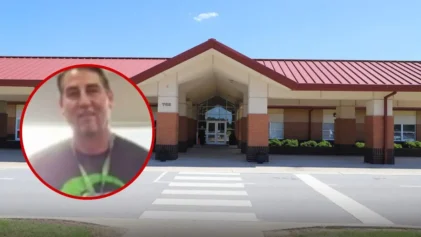Starting more than 150 years ago, a plot of land began being used as the final resting place for what became some 170 Black people in a Georgia county where they eventually became the only African-Americans allowed to remain within its borders.
The Tolbert Street Cemetery is off the beaten path, nestled near a wooded area in Cumming, Georgia, about 40 miles north of Atlanta. The small cemetery is less than an acre. It’s dotted with a handful of headstones and countless other quartz and other stones marking the head and food of the 170 graves.
“I grew up in Forsyth County, longtime resident, been by there numerous times and never really knew it was there,” said David McKee, Leadership Forsyth class member and Assistant Forsyth County Manager.
The Tolbert Street Cemetery dates back to the 1870s — or perhaps earlier. Kathy Hines, is a researcher and was part of the Leadership Forsyth class that restored the historic African-American cemetery that shares a story of a once thriving Black community’s resilience and Georgia’s dark history of racism.
Hines says when she was at the cemetery for her research, “you can feel the spirits, you can feel people there.”
“I had heard how difficult it is for the Blacks to do research and find information on family, it’s very difficult,” Hines said of her experience researching Black people buried in the cemetery.
Hines says deed records trace the land back to the Colored Methodist Church of Cumming. The cemetery was used as a family burial site, and some of the dead are believed to have been enslaved.
“The way the stones are cut, they have a notch at the top, that’s an indication that was used during that time that they were slaves,” Hines said.
Forsyth County had about 1,100 African-Americans living within its borders until the death of Mae Crow led to purge of Black people from the county in 1912.
Crow was an 18-year-old white woman who was found beaten and bloodied in some Forsyth County woods on a September day in 1912.
She died two weeks later from her injuries. Inflamed by rumors Crow had been raped, white mobs blamed the Black community for her death. Four Black people were arrested in connection with Crow’s death, and most of those arrested were lynched.
“One of the men, some white supremacist went in and drug him out of the jail, they proceeded to beat him, and he was hung,” Hines said.
Hines says the other two men who were arrested and convicted of Crow’s assault, in a one-day trial were also lynched. The fourth person arrested was a woman who was married to one of the men.
She was spared being lynched, but over a period of the next two months a campaign of arson, shootings, and death threats drove virtually every Black resident out off the county.
“There were a lot of accusations and the Blacks felt unsafe, understandably and so a lot of them left,” Hines said of the mass exodus of Black people in the nearly 1900s in Forsyth County, Georgia.
Although most of the graves remain unmarked, the year 1905 is one of the last years identifiable on the headstones in the cemetery.
Last September, Leadership Forsyth chose the Tolbert Street Cemetery as their class project to restore it because of its rich history. Chelsee Nabritt is also part of the Leadership Forsyth class and says Boy Scouts helped mark some of the unmarked graves.
“It was about four or five that were marked, a lot of them were not marked. It was literally a rock at the top and a rock at the bottom and then like David said, the Boy Scouts came and painted crosses where they thought the graves were,” said Nabritt.
The fresh landscaping, fencing and mulch are part of the restoration effort, estimated to be worth about $50,000 dollars according to Forsyth County officials, but most of the resources came from donations.
“We spent less than $2,000, everybody in the community was very welcoming and accepting, once we told them what we were doing, people started donating and it was really a community effort,” Nabritt said.
Hines used her family tracing experience, which includes going through ancestry records, marriage records, death records, reviewing old newspaper clippings and census records to trace living descendants of those buried in the cemetery. “Going back through, basically I had to make a tree and work backwards,” Hines said of her efforts.
Hines says she was able to contact two descendants of the people buried in the cemetery.
One of them is Audra McDonald, Grammy and Emmy Award-winning singer and actress who has family ties tracing back to the Tolbert Street Cemetery. Another family Hines contacted lives in Indiana. Hines described them as stunned to learn of their late relatives in the historic cemetery.
“They knew they had family that lived in Cumming, but there was no record of what happened to them,” Hines said.
Hines says as they move forward with the restoration project, she plans to continue researching and connecting living descendants with ties to the Tolbert Street Cemetery. She says it’s almost like a calling from God.
“I still want to reach out to more family and help them to know where their family rests,” said Hines.


